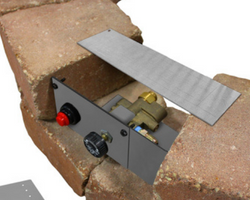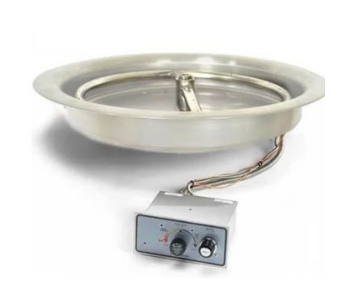The Complete Guide to DIY Fire Pit Burners
The Complete Guide to DIY Fire Pit Burners
Installing your gas fire pit is an exciting and fun DIY project that the entire family will enjoy for years to come. One aspect you’ll want to get right is choosing the best burner system for your new DIY fire pit. To help point you in the right direction, we’re going over your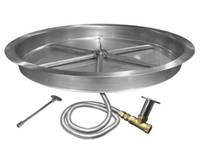 options for DIY fire pit burners along with some tips for a smooth and successful project.
options for DIY fire pit burners along with some tips for a smooth and successful project.
First, you have a couple of initial decisions that need to be made before you begin your search for the perfect burner system.
Choosing a Fuel Source for a DIY Fire Pit
Your fire pit will run on either natural gas or liquid propane gas (LPG) as its fuel source. If your home and property are already set up to use one over the other, then you should go with it as your fire pit’s fuel source. Choosing your fuel source will be the first deciding factor in choosing a fire pit burner for your feature.
Running Gas Lines to a DIY Fire Pit
Along with connecting your burner to your preferred fuel source, you’ll also need to run gas lines out to your fire pit. We recommend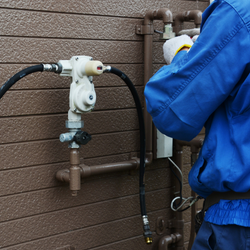 contacting a professional technician to come out and run the gas lines to your fire pit.
contacting a professional technician to come out and run the gas lines to your fire pit.
Whether you’re running propane gas lines or you’re connecting to a natural gas public utility, you’ll want to take extra care and contact a professional for this step.
Of course, there are other considerations to make as well. For example, if you don’t already have a spot in your yard picked out for your fire pit, you’ll certainly want to do that before contacting a professional to come out.
If you don’t already have a structure built, then you’ll also need to choose a material such as pavers or retaining wall blocks for the structure and housing of your fire pit. It’s also smart to outline your basic structure and frame your pavers before making the structure permanent with mortar or concrete adhesive.
All of these will help you determine the type of burner that will work best for your DIY fire pit.
Fire Pit Burner Materials
Once you have a basic fire pit structure in mind, and all of your pavers or blocks ready to go, you can start thinking about burner systems or kits. One of the first considerations to ma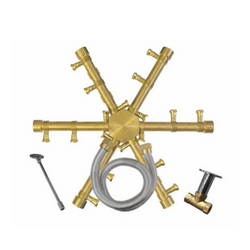 ke involves your fire pit burner material. Fire pit burners can be made of different materials including:
ke involves your fire pit burner material. Fire pit burners can be made of different materials including:
-
Aluminum
-
Steel
-
Stainless steel
-
Brass
Typically, we recommend choosing a stainless steel fire pit burner. Stainless steel resists rust and corrosion and stands up to harsh weather elements.
For example, HPC’s stainless steel Penta burner is an extremely popular option for anyone looking to install a burner that starts every time regardless of weather conditions. The patented Penta burner is designed at an angle to allow water to run off the pipe and out of your burner pan. It’s also designed to prevent water from impacting the flow of gas to your burner ports and keeps water from pooling inside the burner pipes.
Fire Pit Burner Shapes
As you decide on the type of material you want for your DIY fire pit burner, you’ll also want to consider the size and the shape of the burner you want. When installing a burner system for your new DIY fire pit, you’ll have several options for the shape of the burner.
Here are some of the different options you’ll see for fire pit burner shapes:
-
Round: these are commonly-used traditional circle-shaped burners with burner holes distributed around the burner itself.
-
Square: this is another common shape for fire pit burners with burner holes arranged in the shape of a square.
-
Tree: these are designed with one solid pipe down the middle and several smaller pipes intersecting it to resemble the branches of a tree.
-
Linear: these burners are one long straight pipe with burner holes placed every inch or two to burn in a straight line and offer a contemporary look for your fire pit.
-
Penta: these star-shaped burners are designed to give the appearance of a full fire blazing in your fire pit.
-
H Burner: these burners are double linear burners that give the appearance of two parallel rows of fire burning side by side.
-
S Burner: these burners are in an S shape to give your fire pit flames a curve as they burn in your feature.
Although you can’t go wrong with any of these fire pit burner shapes, it all comes down to personal preference. We’ve already touched on Penta burners, but other popular shapes include S burners and H Burners. We've included some examples below so you can start comparing burner shapes for your DIY feature.
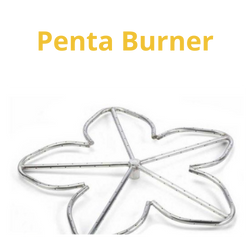
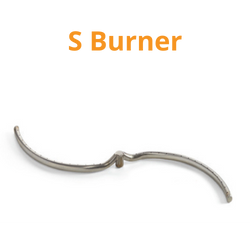
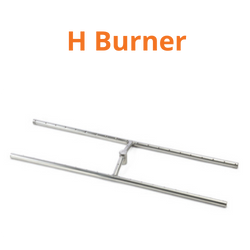
Once you’ve settled on the shape you’d like for your burner, the next decision you’ll make for your DIY feature is fire pit burner size. Of course, you don’t have to make your decisions in this exact order, but we’re breaking it down like this for this article.
Fire Pit Burner Sizes
To figure out what size burner you’ll need for your DIY fire pit, you’ll need to know your interior diameter. Whether you’re converting a wood fire pit or building your gas-burning feature, the interior diameter of your fire pit will help determine what size burner you’ll need for your feature. Burners range in sizes from as small as 6” to as large as 120” but it all depends on the size of your opening.
Most industry and construction professionals go with an exterior diameter of around 40” leaving an interior diameter of 32-37” depending on the width of the pavers or blocks. Regardless of the size, your fire pit burner should have approximately 12” of clearance from the edge of the burner system to the edge of the fire pit.
.png?1651252571184)
For example, a 48” burner pan insert will use a 36” burner, automatically providing you with the right amount of clearance from the start. If you’re not using a burner pan, you’ll want to ensure at least 12” of clearance from your burner to the edge.
It’s also important to understand that having a larger size burner does not mean you’ll have bigger flames. The size of your flames for a gas-burning fire pit is dictated by aspects such as burner ports, the fuel source and the quality of your connections. Having a larger fire pit burner simply means you’ll have a larger area for the flames to burn, but not larger or taller flames overall.
Importance of Choosing the Right Size Burner for a Fire Pit
It’s important to choose the right size burner for your DIY fire pit. Having a fire pit burner that’s too big or too small can cause issues with the flames and disrupt the flow of gas to your fire pit. This can also lead to dangerous conditions with your fuel source and cause damage to your outdoor fire pit and your property or both.
Fire Pit Burner Pans
A fire pit burner pan holds your fire pit burner at your desired level. Without a burner pan, you’ll need to use lava rock or fire glass to fill the bottom of your fire pit and hold your burner at its desired level. This takes more fire glass or lava rock material, so you’ll spend more money on these items without a burner pan but it’s an option.
Drop-in burner pans make it easy to place your fire pit burner at its desired height. There are two types of burner pans – flat and bowl (round). Flat burner pans are placed on the edge of your fire pit and need to be secured with either a bracket or with the layers of your pavers or blocks. Round or bowl-shaped pans, on the other hand, have a lip or flange around the edge that allows them to sit on top of the bricks and drop into the opening of your fire pit. These are commonly referred to as drop-in burner pans.
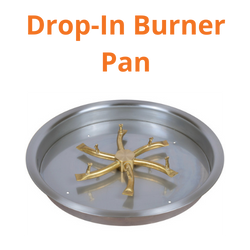
.png?1651253512682)
Regardless of the type of pan you go with, a fire pit burner pan is simple to install. Your fire pit burner sits in the pan and both are covered by lava rock or fire glass. This is another reason why it’s important to build your paver base without making it permanent. You will likely need to install parts of your burner system in between the layers of your pavers or blocks.
Burner Pans, Liquid Propane Gas and Vents
If you’re thinking about using LPG for your fuel source, then it’s important to understand the properties of propane gas. Propane gas is denser than air, making it prone to sinking when it’s used in a tight, confined area without ventilation.
And as we discussed, a fire pit without a burner pan needs more fire glass or lava rock to hold the burner up to its desired level. This type of setup combined with propane creates an added risk for explosion and injury. The tight, packed-in fire media without a burner pan and proper ventilation create an environment for propane to sink and linger, leading to an explosion, injury or both.
Fire Pit Vents and Vapor Barriers
Another burner aspect you’ll want to consider for your fire pit is whether or not to include vents along the base of your structure. Installing vents along the base and a vapor barrier between the ground and your structure will help prevent moisture from reaching and potentially damaging your burner.
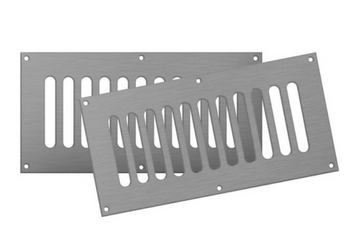
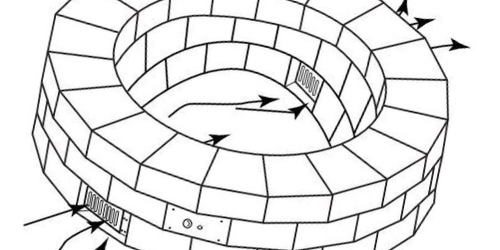
Burner pans come with predrilled holes that allow any standing water to drain out the bottom of the pan and not damage your burner. And some models of fire pit burners are designed to shed water. Combine this with proper ventilation to ensure your fire pit burner is fully protected from moisture and condensation.
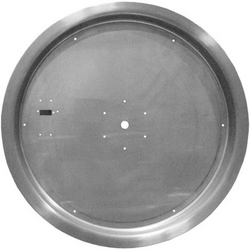
.png?1651265825790)
Proper ventilation isn’t needed only for protecting your burner from rainwater. Having vents and vapor barriers also prevent ground moisture from impacting your burner system. Ground moisture can cause damp environments that leave your fire pit burner constantly exposed to wet conditions even when it’s dry outside.
DIY Fire Pit Burner Ideas
The best part of installing a fire pit is the first time you light the flames and gather around the fire with friends and family. But before you get to that moment, you’ll need to choose the right fire pit burner system for your new DIY feature. 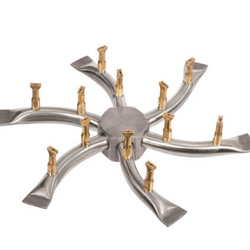
You have a few options for your fire pit burner system such as:
-
Only the burner – supported underneath by fire media (not recommended for LPG fuel sources)
-
Ready to finish DIY fire pit kit
-
Fire pit burner insert kit
Now that you know more about your different options, it’s time to start putting it all together and designing your new DIY fire pit burner. As we’ve discussed, you’ll have different options for things like burner size and shape, but there’s more to it than that.
You can choose to piece out your fire pit burner system by purchasing the burner, burner pan and all of the ignition system parts and accessories individually. But one of the easiest options you have for your fire pit burner is to go with an insert kit or a ready-to-finish DIY fire pit kit.
DIY Fire Pit Kits
If you go with an entire DIY fire pit burner kit, all you need after that is the pavers or bricks. you’ll have several options to choose from. Kits come with choices for burner shapes and sizes plus everything you need to install and enjoy your new fire pit burner such as:
-
Burner
-
Burner pan
-
Burner pan mounting brackets
-
Fire media
-
Vents
-
Ignition system and flex connector line
If you go with one of these kits for your fire pit, then all you need after that is the pavers or retaining wall block. Ready to finish fire pit burner kits are an easy way to get everything you need to complete your DIY build and assemble your feature’s burner.
These complete fire pit kits also come with instruction manuals for installing the parts of your new feature. To ensure you’re installing the kit properly and following all clearance and safety recommendations, you should always follow the instruction manual for specifics, measurements and procedures. You’ll also want to check local codes to ensure your fire pit is legal and built to regulations.
Fire Pit Burner Insert Kits
With an insert kit, you’ll get a burner pan, a burner, a gas flex line and an ignition system.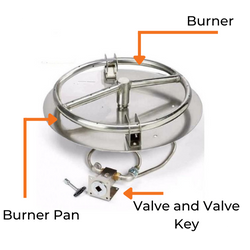
Drop-in fire pit inserts with a burner pan will already have plenty of clearance built-in, so you don’t have to worry about having enough space between the burner and edge.
However, you’ll still need parts and accessories such as vents, fire media and the pavers or bricks before you fully finish your DIY fire pit.
Insert kits are an excellent option if you already have the structure built and just need a burner to finish your project, or if you’re just replacing an old, worn-out burner in an existing fire pit.
Insert kits have options for various types of burners and are categorized according to the type of ignition system its equipped with such as:
-
Match-lit ignition
-
Push-button ignition
-
Electronic ignition (AWEIS)
-
Small LPG tank systems
The different types of fire pit inserts come with options for burner pan styles as well. Remember, you can choose a flat burner pan or a drop-in pan. While these are all excellent options for lighting your fire pit, you’ll want to choose the one that’s personally right for you. Let’s go over each of these types of fire pit inserts so you can make the best decision for your new DIY feature.
Fire Pit Inserts: Match-Lit
The most basic type of burner is a match-lit fire pit burner. A match-lit system works by lighting a long-stemmed match or long grill lighter to ignite the gas and start the flames.
.png?1651255676771)
Simply use a valve key to turn on the supply of gas to your outdoor fire pit and use a match or lighter to ignite the flames. From there, you can adjust the size of the flames by increasing or decreasing the supply of gas to your feature.
Match-lit fire pit insert kits come with everything you need for your DIY fire pit burner system including:
-
Burner
-
Burner pan
-
36” whistle-free flex gas line
-
Valve and valve key
-
Valve mounting brackets
-
Match-lit ignition system
You’ll still need to purchase your fire media separately, but our fire pit inserts come in a range of sizes and shapes to fit your fire pit. Mix and match your fire pit burner shapes, sizes and burner pan shapes and sizes to find the one that works best for your feature.
Fire Pit Inserts: Push-Button
A push-button fire pit system has several advantages. A push-button system works by creating a spark to ignite the flames of your fire pit without needing to use a match or lighter.
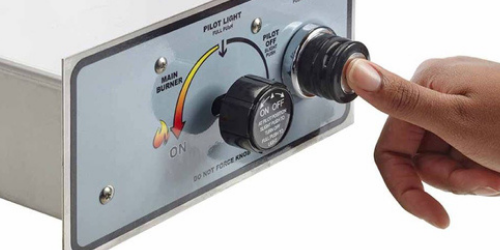
Another benefit of using a push-button system is not having to get too close to the flames as you light them. Instead of reaching your hand in with a long-stemmed match or grill lighter, simply push a button and your fire pit is up and running.
With a push-button system, all you need to do is turn the knob to start the flow of gas and push a button to create the spark you need to light your fire pit.
Similar to the match-lit fire pit inserts, the push-button insert kits come with everything you need to get your fire pit up and running in no time. With a push-button kit, you’ll receive:
-
Burner and burner pan
-
Valve and valve key
-
Push-button ignition
-
35” whistle-free flex gas line
Kits come pre-assembled so installation is quick and easy. Everything operates from one AA battery, making it the perfect setup for any outdoor space or patio area.
Fire Pit Inserts: Electronic Ignition (AWEIS)
Of the three types of fire pit inserts and ignition systems, electronic ignition is by far the easiest to operate. Electronic fire pit ignitions are an All-Weather Electronic Ignition System (AWEIS) and designed to withstand harsh weather elements such as rain, sleet and intense direct sunlight.
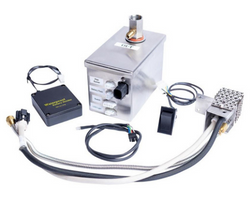
.png?1651260880393)
AWEIS systems use electricity and a battery to light the flames of your fire pit while you keep a safe distance. These systems eliminate the need for lighting matches or pushing buttons and allow you to light your fire pit from a distance using a wall switch or a connected Bluetooth device.
An electronic ignition insert kit comes with the following items:
-
Fire pit burner made from 18-gauge stainless steel
-
Burner pan
-
Electronic ignition system (AWEIS)
-
24” whistle-free flex gas line
Electronic ignition insert kits make installing your fire pit burner and ignition system easy. All of the burners for these insert kits are made of 18-gauge stainless steel. 18 gauge stainless steel refers to the thickness of the burner.
The lower the gauge, the thicker the steel. 18 gauge stainless steel resists dents and bending, making it an ideal thickness and material for outdoor fire pit burners.
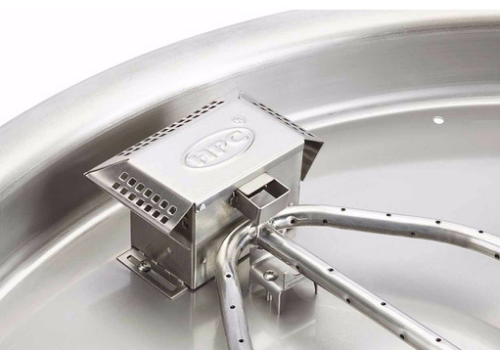
Although these systems can be expensive, they’re a preferred option for many homeowners looking for the safest and most reliable fire pit lighting option. An AWEIS is designed to light in any weather or wind conditions, so you know a peaceful evening by the fire pit is always possible with the flip of a switch.
Fire Pit Inserts: Small LPG Tank Systems
If you’re using a small propane tank for your fire pit’s fuel source, you’ll want to choose a compatible burner system. Luckily, we have fir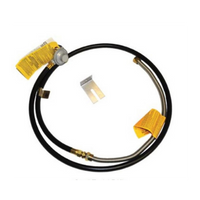 e pit insert kits designed specifically for running on small LPG tanks and systems.
e pit insert kits designed specifically for running on small LPG tanks and systems.
A small LP tank system works similar to a propane gas grill and uses the same type of propane tank.
Our propane fire pit inserts are designed specifically for being used with a small LPG tank and come with a propane tank hook-up and gas flex line.
All of these kits are pre-sorted for compatibility with small LPG tanks. The burners, pans and gas lines in these kits are all compatible with a propane DIY fire pit and a small tank.
Summary of DIY Fire Pit Burners
You'll have many different options for fire pit burners and insert kits. The most vital decisions are choosing a burner that's the right size and pairing it with your chosen fuel source. From there, find your preferred ignition type, burner ring shape and choose whether or not you want to use a flat burner pan or a drop-in, bowl style pan.
Of course, you could always go with a complete DIY fire pit kit and only worry about choosing the best pavers or blocks for your project. A DIY fire pit kit means you can choose the system and accessories and build your structure to fit.
Another option is a fire pit insert kit. Insert kits come with a burner, burner pan (flat or drop-in), gas flex line and a valve system. You'll still need a few accessories and installation parts such as vents and burner pan collars for drop-in pans, but inserts are an excellent way to finish off your DIY feature or replace an old burner and get your fire pit up and running again.
Protect Your DIY Fire Pit and Burner System with Accessories from Fireplace Doors Online
Now that you have everything you need to complete your DIY fire pit project, it's smart to consider ways to protect your new feature. Shop Fireplace Doors Online for all of your protective fire pit accessories including covers, snuffers and wind guards.
Do you need help finding the right burner for your DIY fire pit? The pros at Fireplace Doors Online are standing by, ready to help. Contact us online or give us a call at 888-986-1535 and a member of our dedicated team will be happy to assist!
No posts found

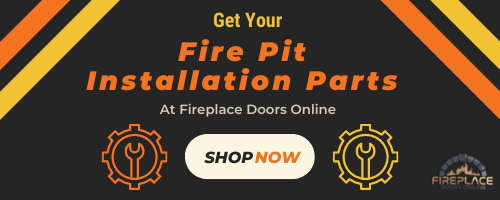
.png?1651262660941)
